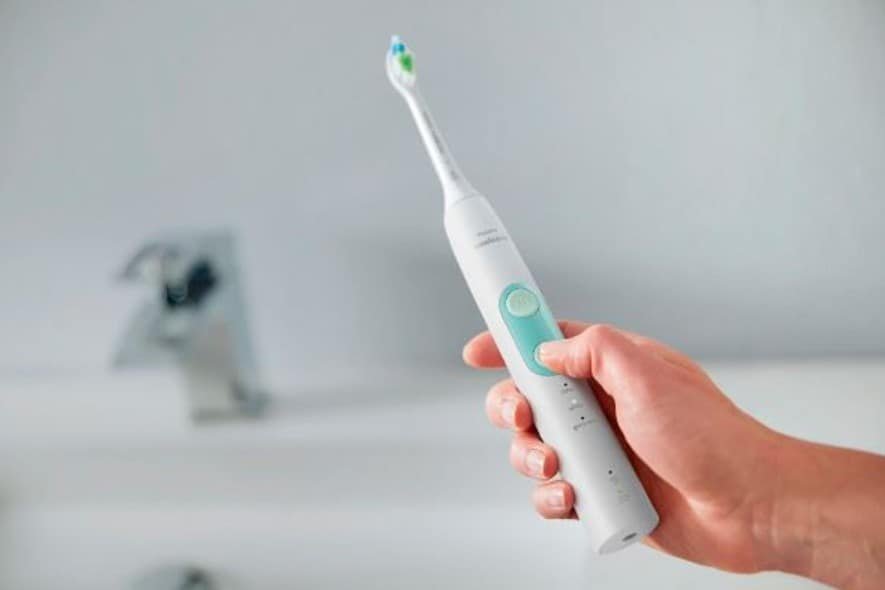How to maintain impeccable oral hygiene and make tooth brushing more effective, even fun? The answer, you know it: the electric toothbrush. Recommended by dentists, it keeps getting better. But how do you choose the right electric toothbrush for you? Follow the guide.
What type of electric toothbrush to choose?
With your old electric toothbrush, you said goodbye to cavities and plaque. Thanks to constant innovations, electric toothbrushes are even more efficient and comfortable. There are different technologies:
- The oscillating-rotating electric toothbrush: It refers to 2D technology. The movement of the electric toothbrush is broken down by circular rotation or by oscillation (alternating the direction of rotation). The advantage lies in the access to hard-to-reach places of the jaw, such as behind the molars.
- The pulsating electric toothbrush: It uses 3D technology. The model uses a 2D technique and adds pulsating motion. The brush head moves up and down while keeping the tilt-and-turn system. It works faster: it can reach 10,000 oscillations and 40,000 beats per minute. By comparison, manual brushing operates 600 movements.
- The sonic electric toothbrush: Its brush head adopts a rectangular shape reminiscent of the manual toothbrush. The resemblance does not end there, since sonic technology reproduces the vertical back-and-forth movement of the wrist. Depending on the model, up to 40,000 movements per minute are carried out on your teeth. They produce vibrations, as well as an emulsion of saliva and toothpaste. This set promotes the elimination of dental plaque.
- The ultrasonic electric toothbrush: The medical sector praises the benefits of ultrasound for their cleaning and descaling action on our teeth. Ultrasound not only works against bacteria but also protects the gums. Indeed, the ultrasonic toothbrush does not exert any pressure on the teeth. The only prerogatives: use special toothpaste and put up with noise. The ultrasonic toothbrush performs 96 million beats per minute, i.e,… 192 million movements! After a few uses, the ultrasonic toothbrush exterminates bad breath and encrusted stains.
Autonomy and pulsation: the two fundamental criteria
Two criteria are common to all electric toothbrushes: autonomy and speed.
- An electric toothbrush that offers good autonomy reduces the need for recharging, which extends its life. At the entry level, the battery offers 40 to 90 minutes of autonomy, while the high-end models can go up to 4 hours.
- The pulsations (or oscillations) per minute determine the effectiveness of the cleaning. The more the movements intensify, the cleaner your teeth become. Identical observation for the depth of the field of action, which strengthens according to the number of pulses. The Philips DiamondClean electric toothbrush performs up to 62,000 brush head movements per minute, reaching into the interdental spaces.
What features for an electric toothbrush?
The comfort of use and the performance of an electric toothbrush can be improved with the following features:
- The timer: After two minutes, the timer signals, by sound or vibration, the need to stop brushing your teeth. Some models warn you to change sides every thirty seconds.
- Pressure sensors: The sensors warn you if too much pressure is placed on the teeth and the gums. The speed slows down automatically, then returns to normal as soon as the risk is eliminated.
- Brushing modes: Some electric toothbrushes have several: whiteness, gum care, tongue cleaning, etc.
- Connected mode: The electric toothbrush communicates with your smartphone or tablet by BlueTooth. Cleaning level, duration, brushing progress, statistics: a wealth of data is available to you to monitor your oral hygiene!
Oral-B vs Philips, the match for electric toothbrushes
Oral B and Philips are vying for the title of the best brand of electric toothbrushes. Both manufacturers are constantly flooding the market with ever more innovative models.
- Oral-B joins forces with Braun to provide expertise in oral hygiene. The range under the Oral-B brand mainly focuses on oscillating-rotating pulsating toothbrushes (3D) like the Pro 670 Cross Action model. Nevertheless, Oral-B is one of the pioneers of the connected electric brush like the Smart 4 model. Personalizing your toothbrushing is one of Oral-B’s priorities, which offers many specific brushes (sensitive gums, stain removal, etc.).
- The Dutch firm Philips offers the Sonicare range which – as its name suggests – is based on sonic technology. The ProtectiveClean 4500 promises brightened teeth in just one week! Philips toothbrushes are available in a wide range (classic, deep, gum care, etc.). You can recharge some without connection to a wireless tray.
Not yet convinced? Here are 5 good reasons to switch to the electric brush

